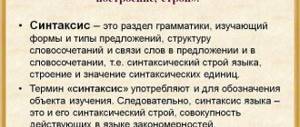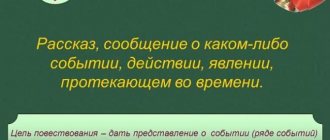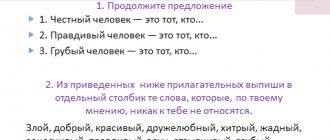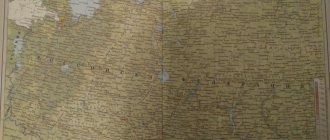Download material
so UNT / Lesson developments / Russian language lessons
Notes for the Russian language lesson “Repetition of what was learned in the section “Syntax and Punctuation”, grade 5
07/20/2015 5816 623 Pomogaeva Olga Anatolyevna Purpose of the lesson: to systematize knowledge on the topic “Syntax and punctuation” Planned educational results: Subject: know the main features of a simple and complex sentence, the concepts of “main and minor members of a sentence”, “one-part sentences”, “homogeneous” isolated members of a sentence”, “addresses and introductory words”; be able to: distinguish between complex and simple sentences, place punctuation marks correctly, perform punctuation analysis of sentences, analyze linguistic units. Meta-subject: the ability to exercise speech self-control in the process of educational activities and in the everyday practice of verbal communication; the ability to evaluate one’s speech in terms of its content and linguistic design; the ability to find grammatical and speech errors, shortcomings, and correct them. Personal: awareness of the aesthetic value of the Russian language; respect for the native language; the desire for speech self-improvement. Basic concepts of the lesson: Syntax, punctuation, phrases, simple and complex sentences, members of a sentence (main and secondary), homogeneous members of a sentence, address; punctuation marks; syntactic and punctuation analysis, dialogue, direct speech Resources: Textbook - “Russian language. 5th grade” - authors Baranov M.T., Ladyzhenskaya T.A. and etc.; Computer, multimedia presentation, assignment handouts; Lesson type: Repetitive-generalizing.
Lesson stage Teacher's activities Students' activities 1. Organizational stage Welcomes students, checks their readiness for the lesson. Creates an emotional mood for the lesson. - Hello, dear guys. I am glad to welcome you to the Russian language lesson. Today is such a beautiful day. There should be a good mood in the class. Let's give each other a smile. Turn to each other and smile. After all, a smile is the most amazing thing; in difficult times of life, it does wonders. Remember, as the song says: “... a smile will make everyone brighter!” Is everyone ready for class? Let's wish ourselves success. Greet the teachers and check their readiness for the lesson. 2.Motivation. Determines the type and form of the lesson. Leads them to formulate the theme, purpose and objectives of the lesson. (Slide No. 2-6) -Today we are conducting a repetition lesson. Let's conduct the lesson in the form of a competition. I will ask questions, you will answer one by one. I hope that you will show not only your knowledge, but also how you can work in a team. Success will depend on your answers, so be careful and disciplined, try to work together, and be respectful to each other. -We answer only by raising a hand, do not shout, do not prompt, do not get distracted. So, the first task is to determine the topic of the lesson. What are we going to repeat? A crossword puzzle (Slide 2) will help us answer this question, which we must guess by answering the questions and writing the first letters in the empty cells 1 2 3 4 5 6 7 8 9 syntax 1. The first letter of the name the main member of the sentence, which denotes an action, state, attribute of an object, answers the questions what to do? what is the subject? what is an item? can be expressed by a verb, adjective, noun, or underlined by two features (predicate). 2. A frequently occurring conjunction that connects homogeneous members and simple sentences as part of a complex compound (and). 3. The first letter of the name of the type of sentence by intonation. The sentence is pronounced quietly, calmly (non-exclamatory). 4. The first letter of the name of the punctuation mark, which is placed between the subject and the predicate if both main members are expressed by a noun in the nominative case (dash). 5. A frequently occurring conjunction that connects homogeneous members and simple sentences as part of a compound sentence, it is always preceded by a comma (a). 6. The first letter of the name of a punctuation mark, which is placed in sentences, highlighting direct speech (quotes). 7. The first letter of the name of a syntactic unit consisting of two or more words related to each other in meaning and grammatically (phrase). 8. The first letter of the name of the case, the questions of which are answered by the subject (nominative). 9. The first letter of the name of a part of speech, with the help of which homogeneous members and simple sentences are connected as part of a complex one (conjunction). As a result, the word “syntax” was formed (Slide No. 3). And what section is syntax closely related to? (punctuation). So, the topic of the lesson is... . Let’s write down the topic of the lesson in the notebook “Repetition of what we learned in the section “Syntax and punctuation.” (slide number 4) - How did the words “syntax” and “punctuation” come about? (slide number 5). (Slide No. 6). (Punctuation from punctum - dot. The syntax of the Greek word consists of 2 parts: the prefix “sin” means compatibility, totality (corresponds to the Russian prefix “so”), the word “taxis” is a military term and means “formation, column, place in ". Later, scientists adapted this term to grammar, since grammatical structure requires clarity and order.) Students solve a crossword puzzle and answer questions on this topic. Formulate the topic and goals of the lesson and write it down in a notebook.
They answer questions and master linguistic terms. Activate the studied information 3. Goal setting and planning. -Look at the topic of the lesson. What should we repeat today? (Repeat the basic information in the “Syntax and Punctuation” section) – For what purpose will we repeat this? (To be able to apply it in practice). -So, today’s lesson will help you systematize the material you’ve studied, prepare for the test, and teach you how to work with a greater degree of independence. You guys will have to apply what you have learned while doing various exercises. Good luck! Formulate the purpose of lesson 4. Work on the topic of the lesson. The teacher invites students to recall the theoretical material of the completed section. 1. Frontal survey. 1. Type of sentence according to the purpose of the statement, which contains a question (interrogative). 2. A punctuation mark that is placed between homogeneous members of a sentence that are listed and between simple sentences as part of a complex sentence (comma). 3. A secondary member of a sentence, which denotes a feature of an object and answers the questions: which one? whose? (definition) 4. A word or combination of words that denotes the one to whom a speech is addressed (address) 5. A type of sentence in structure that contains only one grammatical basis (simple) 6. A minor member of a sentence that denotes place, time , method of action and answers the questions where? Where? When? Why? (circumstance). 7. Sentences in which there are minor members of the sentence (common). 8. Members of a sentence that answer the same question and relate to the same member of the sentence (homogeneous) 9. A conversation between two or more persons (dialogue). 10. Exactly reproduced someone else’s speech, conveyed on behalf of the one who spoke it (direct).
2. Vocabulary work (Slide No. 7-8). You did a good job with this task. But don't forget that syntax and punctuation are related to spelling. Let's try to check your literacy. The slide contains words with missing spellings. Students write them down, commenting on the spelling (one at a time). Synth...xis, grammatical basis, sentence, wonderful..., good...giving, unraveling, please...hundred, unite...unite, quiet...on. -Let's check (Slide No. 8)
3. Five-minute syntactic lesson (working with sentences, drawing up diagrams at the board). The teacher reads the sentences, and the students determine the number of grammatical bases and draw diagrams. (Student at the blackboard). 1. The sun was setting and its slanting rays illuminated the top of a tall oak tree. 2. Frost struck at night, and the flowers froze by morning. Question: what role does the conjunction AND play in sentences 1 and 2?
Frontal work.
Answer questions.
Find spelling patterns in words and explain them.
Types of proposals, drawing up sentence diagrams
The role of the conjunction in a sentence. 5. Generalization and systematization of knowledge. 1. Parts of speech. -Now let’s check how you know the parts of speech, because sentences and phrases consist of words expressed by different parts of speech. —Which word has the wrong part of speech? (Slide No. 9) 1) Sat down - a verb in the past tense; 2) And – preposition; 3) Tall – adjective; 4) Top is a noun. Answer: 2
2.Working with phrases. in groups (at desks), mutual checking (exchange notebooks). - What is a phrase? — Give examples of phrases that are not phrases. — I name phrases, girls write down only phrases, boys write down things that are not phrases. Leaves are falling, strong wind (s.s.), wonderful day (s.s.), yellow and red, rainy autumn (s.s.), near the forest, flying quickly (s.s.). -We're checking. Let's exchange notebooks. -How are the main words expressed in the phrase? -What kind of phrases are there?
Repeat learned information about parts of speech
The ability to find the “extra”
Repetition of theoretical information about the phrase.
Work in groups
6. Physical education lesson The teacher organizes a physical education lesson.” (Slide 15) - Now we will conduct a physical education lesson. Since today we are reviewing the material we have learned from syntax and punctuation, the warm-up will be related to knowledge of the terminology that we use. Rules of the game. Students stand up from their seats, hands on their belts. The teacher names various terms. If the terms relate to syntax, make a forward tilt, to punctuation - clap, but if to other sections of the language - to the left. Prefix, grammatical basis, phrase, root, word stem, comma, circumstance, dash, suffix, sentence, address, letter.
Students perform exercises 7. Application of knowledge and skills in a new situation 1. Assignment in envelopes (Slide 10-11). - Read the sentence: The wind carried the seeds into the marshy swamp. -What is the grammatical basis of the sentence? -Guess which members of this sentence we are talking about? 1) Depends on the noun, denotes a feature of an object, answers the question what? (fuzzy definition) 2) Indicates the place of action, depends on the predicate-verb, answers the question where? expressed by a noun with a preposition? (adverbial place in the swamp) 3) Depends on the predicate - verb, denotes an object, answers the question what? expressed by the noun blame. case? (addition seeds) -What are these members of the sentence called? (minor) -Write this sentence in your notebook, sorting it out by members of the sentence.
2.Construction of proposals. (Student works at the blackboard) 1) From the sentence “A breeze ran through the garden with a quiet rustle,” take an adjective that acts as a definition, put it in the nominative case, feminine, singular; (quiet) 2) From the sentence “During the night the ground was covered with fluffy snow,” take a circumstance and use this word as the subject; (night) 3) Add a verb from the sentence “Mom sank down on the sofa out of fatigue”; (sank down) 4) From the sentence “A fast-winged plane flew over the city,” take the circumstance (over the city). Answer: Quiet night fell over the city. Read the entry: - What did we do? (sentence) -Signs of a proposal? (semantic completeness, presence of a grammatical basis) -What sentences do we know? (union and non-union) -What is the difference between SSP and SPP? - Let's find a grammatical basis. Simple sentence or complex? Give a description. -We're checking.
3. Find sentences that correspond to the diagrams (Slide 12-13). -On (Slide No. 12) you see sheets with proposals. Find sentences that match the diagrams and write them in your notebook. 1)[– — =] 2)[– =], and [– = ] 3)[Oh,... ]! 4)[...], (what...). 5)A: “P”. 6) . 1) A book is the best companion. 2) The guide said that there were bears in the forest. 3) Guys, take an active part in competitions! 4) The sea calmed down and only occasionally sighed dully. 5) The door quietly opened, and the princess found herself in her bright upper room. 6) And from the platform they say: “This is the city of Leningrad.” -Check (Slide No. 13)
4.Game "Third Man". (Slide 14) - Find the extra word: 1) Simple, non-union, complex; 2) Definition, circumstance, subject; 3) Declarative, exclamatory, non-exclamatory; 4) Simple, uncommon, widespread. Analysis of the sentence (incomplete) by members of the sentence with recording in a notebook.
Frontal survey.
Students compose a sentence and make a complete syntactic analysis of it.
Repetition of theoretical information about the proposal.
Independent work with self-test according to the sample
Self-control and correction
See the downloadable file for the full text of the material.
The page contains only a fragment of the material.






